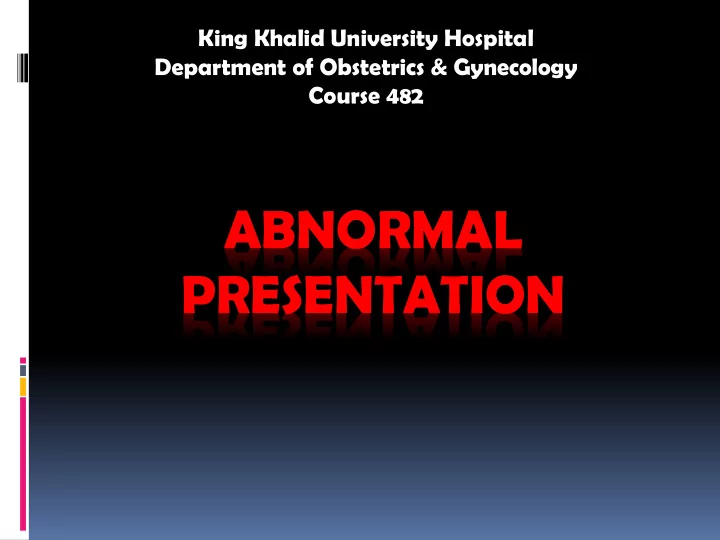

King Khalid University Hospital Department of Obstetrics & Gynecology Course 482 ABNORMAL PRESENTATION
Occipital bone is the landmark in vertex presentation. Mentum is landmark for face presentation, Frontal bone is land mark for brow presentation
MALPRESENTATIONS Fetal lie . This is the relationship of the longitudinal axis of the fetus to longitudinal axis of the mother. There are three lies longitudinal , oblique , and transverse lie . Fetal attitude , this is the relationship of the different parts of the baby to each others , usually flexion attitude .
Presentation. It is which part of the fetus occupies the pelvis eg ,cephalic , breech , shoulder presentation .
BREECH PRESENTATION Baby is presenting with buttocks and legs and incidence is 3% at term . Types . Complete breech where the leg are flexed at hip joint and knee joint , Frank breech flexed hip but extended knee joint . Footling breech with extended hip and knee joints and high buttocks .
Fetal causes . Hydrocephalas , poly hydramnios oligohydramnios , placenta previa , short umbilical cord . Maternal causes . Uterine anomalies, fibroid uterus, small pelvis The most important cause is preterm labor
MANAGEMENT The patient can be offered the option of either vaginal breech delivery , caesarian section or external cephalic version . External cephalic version ECV . Done after 38 weeks. Contra indications . Contracted pelvis , scar uterus, placenta previa , hypertensive patient . Complications. Membrane rupture , uterine rupture, abruptio placenta , cord prolapse
Cont. It should be done in the theater with every thing ready four c/s . If blood group is rhesus negative should receive anti D immunoglobulin
Complications of vaginal breech delivery. Cord prolaps , lower limb fracture , abdominal organs injuries , brachial plexus nerve injuries, Difficulties in delivering the head and intracranial bleeding .
Management of breech delivery Patient in lithotomy position , Cervix should be fully dilated . When buttocks protrudes through the vulva an episiotomy should be performed . Legs are delivered easily unless it is an extended that need to be flexed . With delivery of the umbilicus small loop of cord is pulled down to feel the pulsations . Then delivery of both arms first the anterior then the posterior .
Delivery of the head . Keep the baby hanging to promote head flexion ( Burn Marshal) manoeuvre . Jaw flexion shoulder traction . Obstetrical forceps for the after coming head.
Face presentation Incidence 1-500 . Occurs as the result of complete extension of the head . In majority of case the cause is unknown but is frequently attributed to excessive tone of the extensor muscles of the fetal neck. Rare causes like tumor of the neck , thyroid , thymus gland and cord around the neck
The presenting diameter of the face is the submento – bregmatic , which measures 9.5 cm . Diagnosed in labor by palpating the nose, mouth ,and the eyes on vaginal examination. In case of mento-anterior vaginal delivery is possible and the head is delivered by flexion. If the face is mento posterior the delivery is not possible and patient should be delivered by caesarian section.
Brow presentation Incidence is 1-2000. It occurs when there is less extension of the fetal head than that seen in face presentation, mid way between face and vertex presentation . The presenting diameter is mento-vertical 13.5 cm. Is diagnosed in labor by palpating the anterior fontanelle ,supra orbital ridges, and nose on vaginal examination . Delivery is by caesarian section.
Shoulder presentation It due to oblique or transverse lie in labor . Common in women with high parity . Also occurs in placenta previa , uterine anomalies , pelvic tumor. If diagnosed in early labor with intact membrane and no other pathology external cephalic version can be tried . In case of rupture of the membranes exclude cord prolaps . Delivery of shoulder presentation in labor with rupture membrane is by caesarian section.
Recommend
More recommend